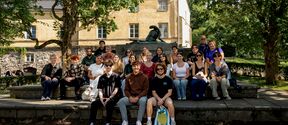Inkjet printers and hydrogen dreams: Millennium Graduate Student winner Sanaz Zarabi Golkhatmi

Prize-winner and Doctoral researcher at Aalto, Sanaz Zarabi lays out the facts decisively. The move to renewable fuels is unavoidable, but the problems emerge when discussing how, exactly. Solar panels and wind turbines, for instance, require lots of raw materials, are susceptible to weather changes, and are relatively ineffective while taking up lots of space. Right now, it seems, many of our best renewable solutions are costly and wasteful. Scientists are frantically exploring ways to remedy the situation.
Enter Sanaz Zarabi. She completed her Master’s in Iran, combining science with engineering ceramics. During that time, she developed an interest in renewables and fuel cells. After graduating in 2019, finding her surroundings too stifling, she applied for PhD positions abroad. Aalto University stood out as a place where she could pursue her interest in renewable energy sources and energy storage in a way that combines her background in science and engineering.
“I knew about Finland, that it was among the best places in Europe. I got admissions from other countries, but I came to Aalto specifically topic-first. I knew this to be a place where I could work on my idea and combine my experience in science and engineering. I consider Aalto my happy place, a second home. I never felt like a stranger here.”
A novel fabrication method
Sanaz Zarabi landed in Aalto in 2020 and got to work. In prof. Peter Lund’s New Energy Technologies (Renewables) group, she developed a way to radically increase the efficiency of energy conversion solutions. The technique may sound both familiar and puzzling to laypersons: it uses inkjet printing – not totally unlike your run-of-the-mill office printer.
“During my studies I had expanded my work a bit to include supercapacitors and lithium-ion batteries, so I thought ‘why not fuel cells?’ Now my topic is additive manufacturing of solid oxide fuel cells,” Zarabi says.
In traditional manufacturing, one often removes extraneous materials to achieve the final product. Conversely, additive manufacturing is the gradual addition of new layers of material to achieve the desired result. Solid oxide fuel cells, in turn, are a promising new way of efficiently creating electricity with chemical reactions.

“We use 3D printing and inkjet printing in our additive manufacturing process. It’s similar to office printers: both apply inks to a system or surface. The inks we use are ceramics-based, and we disperse in a medium and coat them on the surface of the material we print on. We create an ink that has the properties we want and apply it on a system. You can create almost anything like this. The hard part is to design the properties we want and get the resulting ink out of the printer nozzle,” Zarabi says.
This new technique could find use in, for example, fabricating new batteries that store renewable energy much more efficiently, use a fraction of the same material resources, and produce zero waste. Zarabi's pitch rang true with the Millennium Graduate Student prize judges, who awarded her first place.
Hydrogen dreams
Zarabi says that whatever opportunities present themselves, she will consider. But for now, her future plans have two main prongs.
“My aim right now is to finish the PhD, and I dream of working with hydrogen energy, which, to me, is the future. We could take renewable electricity for sources like solar panels, transform it, and store it as the substance hydrogen, which would then be converted back to energy when needed. It could work as batteries, storing electricity as chemical energy. This is the reverse of our solid oxide fuel cell process,” she describes.
According to Zarabi, Finland is investing heavily and doing well in the race for renewables, so she has set her mind on staying in her happy place.
Sanaz Zarabi is a Doctoral researcher in the Academy of Finland Research Fellowship project entitled "Leading-edge next generation fuel cells", funded for 2019-2024. The grant holder is Academy Research Fellow Imran Asghar of Aalto University's Department of Applied Physics.
Read more news

“This hands-on approach is the absolute best way to learn” – Loyola University and Aalto University partnered for the sixth time
The collaboration between Loyola University Chicago and Aalto University Summer School gives Loyola students a unique opportunity to experience the Finnish business landscape, connect with local experts, and explore Aalto University and Finnish culture at the same time.
Your voice gives away valuable personal information, so how do you keep that data safe?
With speech technologies becoming increasingly common, researchers want to make sure we don’t give away more information than we mean to.
Aalto in 2025: Quantum leaps, creative breakthroughs and solutions for a better life
Growth, technology and industrial renewal; human-centred solutions; health and everyday wellbeing; and enjoyable daily life and thriving communities.






